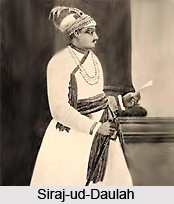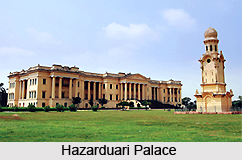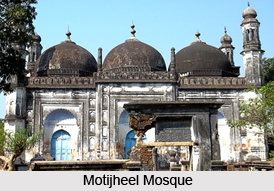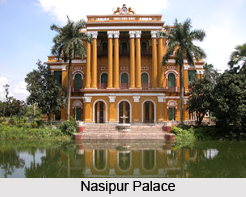 The ancient history of Murshidabad can be recorded from the period when Sasanka, the king of Gouda, established Murshidabad as his capital city. Following Sasanka, his Pala descendants also established their capital city in Murshidabad. During the Pala age, Murshidabad earned an unblemished glory in its unique culture. But the present history of Murshidabad, however documented from the time when Nawab Murshid Kuli Khan shifted his capital from Dacca to Murshidabad. Siraj-ud-daulah was the last sovereign ruler of Bengal who even had his capital in Murshidabad. Finally, when the British occupied Bengal, in the history of Murshidabad a new era started.
The ancient history of Murshidabad can be recorded from the period when Sasanka, the king of Gouda, established Murshidabad as his capital city. Following Sasanka, his Pala descendants also established their capital city in Murshidabad. During the Pala age, Murshidabad earned an unblemished glory in its unique culture. But the present history of Murshidabad, however documented from the time when Nawab Murshid Kuli Khan shifted his capital from Dacca to Murshidabad. Siraj-ud-daulah was the last sovereign ruler of Bengal who even had his capital in Murshidabad. Finally, when the British occupied Bengal, in the history of Murshidabad a new era started.
The history of Murshidabad so far is known is deciphered from the archaeological excavation and the relics of the earliest buildings scattered in the district. The Mauryan influence was introduced with the conquest and the establishment of the Radha region and incorporated it with the territory of Murshidabad by Bimbisara. However there is a mention of the Radha region in the Jain scripture Acharanga Sutra in the 6th century B.C, which reveals that the history of Murshidabad traces back even in the 6th century B.C.
The Mauryan history of Murshidabad though inaugurated by the Mauryan Emperor Bimbisara, the Nandas overthrew the Mauryas and established their supremacy in the entire area of Murshidabad. Finally the vibrant Maurya king Chandragupta Maurya washed away the Nandas and reinstated the Maurya supremacy in Murshidabad. As the ancient history of Murshidabad points out, the Maurya kings ruled Murshidabad for ages and the Ashokan stupas in Kanvasuvarna (falls under present Murshidabad) indicates Murshidabad to be a part of the Maurya Empire for long. The accounts of the Chinese traveler Hiuen Tsang are also an important source regarding the history of Murshidabad.
The post- Mauryan history of Murshidabad was composed by a long session of the Shungas and the Kushanas. The reign of the Shungas cannot be ascertained because there is no extant evidence of their reign in Murshidabad. The Kushana coins, which have been excavated in the Rajbari Danga region of Murshidabad, indicate the existence of the Kushana kings in Murshidabad. The coins indicate that the Kushana kings conducted the business transactions throughout the Middle East and the southeast countries with Murshidabad as the core center.
 The Gupta kings ousted the Kushanas from Murshidabad and they retained their supremacy for longest period, till the 6th century A.D., as the history of Murshidabad reveals. The accounts of the Chinese traveler, I-Tsing, arrived during the Gupta era depict the cultural prosperity that Murshidabad attains under the patronization of the Gupta kings. The Gupta period constituted the glorious chapter in the history of Murshidabad.
The Gupta kings ousted the Kushanas from Murshidabad and they retained their supremacy for longest period, till the 6th century A.D., as the history of Murshidabad reveals. The accounts of the Chinese traveler, I-Tsing, arrived during the Gupta era depict the cultural prosperity that Murshidabad attains under the patronization of the Gupta kings. The Gupta period constituted the glorious chapter in the history of Murshidabad.
However the sovereignty of the Guptas at the end of the 6th century A.D became nominal. The earliest history of Murshidabad however codified in a written document only from the reign of Sasanka. Moreover the inscription of the kings of the time also mirrors the contemporary history of Murshidabad. However Sasanka did not rose in power suddenly. Before the advent of Sasanka, king Ishanavarmana invaded the entire area of Murshidabad and shattered the Guptas. Finally when the Guptas tried to conquer their former kingdom, Mahasenagupta however managed to snatch it away from them and installed his own realm over the extensive areas of Murshidabad. Sasanka was perhaps a vassal chief under him. When the Maukharis were engaged in warfare, Sasanka exploited the disturbed situation to its best and became the king of Gouda, with Kanvasuvarna as his capital. After becoming the king Sasanka extended his kingdom even to the distant west, for which the boundary of Murshidabad also underwent certain changes.
Sasanka, the violent conqueror, engaged in aggressive warfare to extend the kingdom of Bengal and finally since his time for about 100 years, Bengal witnessed a period of long anarchy and internal discord. Finally in the 760 A.D, Gopala introduced was elected the king, who introduced the Pala dynasty in Bengal. About 400 years of the history of Murshidabad was constituted by the Pala regime in Bengal. The remnants of the Pala king Mahipala in the Janigarh sub division indicate that the king has capital in the Janigarh subdivision of Murshidabad, which at that time probably known as Mahipal Nagar. But, when the Sena dynasty rooted themselves in the extensive land of Bengal, the major parts of Murshidabad came under the sway of the Senas and they continued to be the last sovereign Hindu ruler before the Muslim Rule stared in Bengal.
The beginning of Muslim era, as the chronicles of Murshidabad depicts that it was pronounced with the conquest of Bakhtiyar Khalji. The Muhgal chief ousted the last Sena king Lakshman Sena and the old king fled to East Bengal. This event initiated the Turko-Afgan rule in Bengal. The Muslim reign in the history of Murshidabad was an episode marked with ruthless suppression of the native and plunder of their property by the Muhgal personnel.
Fakir-ud-din Mubarak carried out the Turko- Afgan epoch originated by Bakhtiyar Khalji with prosperity. The sultanate period in the history of Murshidabad began in the year of 1338. A Hindu chief, Ganesha again rose in power and overthrew sultan Giyas-ud-din- Ajan Shah in 1417, however it was for a brief spell Bengal was under this Hindu chief.
 Sher Shah established Afgan era in Bengal by occupying Mahmud Shah in Bengal in 1538 and consecrated the throne. During the reign of Sher Shah, Murshidabad was an important center in Bengal. As far the history of Murshidabad dates back, the city was an important trade center during his reign.
Sher Shah established Afgan era in Bengal by occupying Mahmud Shah in Bengal in 1538 and consecrated the throne. During the reign of Sher Shah, Murshidabad was an important center in Bengal. As far the history of Murshidabad dates back, the city was an important trade center during his reign.
Murshidabad was under the different Afghan rulers, until, the last Afghan ruler Dayud Khan was defeated by the Mughals. However it takes a long period of 20 years, to establish the Muhgal supremacy in Bengal. As the ancient history of Murshidabad depicts, during the beginning of 17th century, when the alien communities like the British, French, Dutch and the Americans established Murshidabad as the key site of carrying out business transaction, a group of business community including local Hindu traders, Immigrants from North India and even the Muslim chiefs etc grew up. When the socio-political panorama was vitiated by the discord between the Muhgals and the local natives, the Dutch and the French exploited the situation, to strengthen their military fortifications. The history of Murshidabad records the Dutch and the French establishment in Murshidabad, sowed the seeds of alien colonization in India.
After the Mughals the Nawabs continued to be the ruler of Murshidabad. Murshid Kuli Khan, who shifted his capital ("Dewankhana") from Dhaka to Maksudabad and named it as Murshidabad was the first Nawab of Bengal. His heirs were the superior Nawabs of Bengal and as the history of Murshidabad points out, that Siraj-ud-daula`s reign was the significant episode in the history of Bengal. During his reign, the British established their trade in Bengal and finally defeating him in the battle of Plassey established the political hold of Bengal. Murshidabad, being the capital of Siraj, shared an important role during this period. Finally the British swayed down the Nawab establishment and do away with Siraj. The British reinstate Mir Jafar to the "masnad" of Bengal, just to make hoim a puppet in their hands. The age of the Nawabs was concluded with the full-fledged British rule in India, as well as Bengal.
In 1765, when Shah Alam II attributed the British with the grant of Diwani, The Nawab existed as simple pensioner in the area of the British. The British charge a considerable amount of revenue and the indescribable collection of revenue led to a great famine. Finally the capital was shifted from Calcutta to Murshidabad. On 24th February 1857, when the entire country was aflame with the fire of the sepoy revolt, the Sepoys of 19th regiment of Native infantry of Berhampore regiment revolted. The revolt triggered the first of Independence called Sepoy Mutiny.
 Murshidabad from its very advent has survived to be the capital city of the kings who have inhabited the land for ages. Finally it was during the British imperialism capital has been shifted from Murshidabad to Kolkata. Both the ancient & past history of Murshidabad formed a significant part of the history of India. Sasanka, the violent conqueror, engaged in aggressive warfare to extend the kingdom of Bengal and finally since his time for about 100 years, Bengal witnessed a period of long anarchy and internal discord. Finally in the 760 A.D, Gopala introduced was elected the king, who introduced the Pala dynasty in Bengal. About 400 years of the history of Murshidabad was constituted by the Pala regime in Bengal. The remnants of the Pala king Mahipala in the Janigarh sub division indicate that the king has capital in the Janigarh subdivision of Murshidabad, which at that time probably known as Mahipal Nagar. But, when the Sena dynasty rooted themselves in the extensive land of Bengal, the major parts of Murshidabad came under the sway of the Senas and they continued to be the last sovereign Hindu ruler before the Muslim Rule stared in Bengal.
Murshidabad from its very advent has survived to be the capital city of the kings who have inhabited the land for ages. Finally it was during the British imperialism capital has been shifted from Murshidabad to Kolkata. Both the ancient & past history of Murshidabad formed a significant part of the history of India. Sasanka, the violent conqueror, engaged in aggressive warfare to extend the kingdom of Bengal and finally since his time for about 100 years, Bengal witnessed a period of long anarchy and internal discord. Finally in the 760 A.D, Gopala introduced was elected the king, who introduced the Pala dynasty in Bengal. About 400 years of the history of Murshidabad was constituted by the Pala regime in Bengal. The remnants of the Pala king Mahipala in the Janigarh sub division indicate that the king has capital in the Janigarh subdivision of Murshidabad, which at that time probably known as Mahipal Nagar. But, when the Sena dynasty rooted themselves in the extensive land of Bengal, the major parts of Murshidabad came under the sway of the Senas and they continued to be the last sovereign Hindu ruler before the Muslim Rule stared in Bengal.
The beginning of Muslim era, as the chronicles of Murshidabad depicts was pronounced with the conquest of Bakhtiyar Khalji. The Muhgal chief ousted the last Sena king Lakshman Sena and the old king fled to East Bengal. This event initiated the Turko-Afgan rule in Bengal. The Muslim reign in the history of Murshidabad was an episode marked with ruthless suppression of the native and plunder of their property by the Muhgal personnel.
Fakir-ud-din Mubarak carried out the Turko- Afgan epoch originated by Bakhtiyar Khalji with prosperity. The sultanate period in the history of Murshidabad began in the year of 1338. A Hindu chief, Ganesha again rose in power and overthrew sultan Giyas-ud-din- Ajan Shah in 1417, however it was for a brief spell Bengal was under this Hindu chief.
Sher Shah established Afgan era in Bengal by occupying Mahmud Shah in Bengal in 1538 and consecrated the throne. During the reign of Sher Shah, Murshidabad was an important center in Bengal. As far the history of Murshidabad dates back, the city was an important trade center during his reign.
Murshidabad was under the different Afghan rulers, until, the last Afghan ruler Dayud Khan was defeated by the Mughals. However it takes a long period of 20 years, to establish the Muhgal supremacy in Bengal. As the ancient history of Murshidabad depicts, during the beginning of 17th century, when the alien communities like the British, French, Dutch and the Americans established Murshidabad as the key site of carrying out business transaction, a group of business community including local Hindu traders, Immigrants from North India and even the Muslim chiefs etc grew up. When the socio-political panorama was vitiated by the discord between the Muhgals and the local natives, the Dutch and the French exploited the situation, to strengthen their military fortifications. The history of Murshidabad records the Dutch and the French establishment in Murshidabad, sowed the seeds of alien colonization in India.
 After the Mughals the Nawabs continued to be the ruler of Murshidabad. Murshid Kuli Khan, who shifted his capital ("Dewankhana") from Dhaka to Maksudabad and named it as Murshidabad was the first Nawab of Bengal. His heirs were the superior Nawabs of Bengal and as the history of Murshidabad points out, that Siraj-ud-daula`s reign was the significant episode in the history of Bengal. During his reign, the British established their trade in Bengal and finally defeating him in the battle of Plassey established the political hold of Bengal. Murshidabad, being the capital of Siraj, shared an important role during this period. Finally the British swayed down the Nawab establishment and do away with Siraj. The British reinstate Mir Jafar to the "masnad" of Bengal, just to make hoim a puppet in their hands. The age of the Nawabs was concluded with the full-fledged British rule in India, as well as Bengal.
After the Mughals the Nawabs continued to be the ruler of Murshidabad. Murshid Kuli Khan, who shifted his capital ("Dewankhana") from Dhaka to Maksudabad and named it as Murshidabad was the first Nawab of Bengal. His heirs were the superior Nawabs of Bengal and as the history of Murshidabad points out, that Siraj-ud-daula`s reign was the significant episode in the history of Bengal. During his reign, the British established their trade in Bengal and finally defeating him in the battle of Plassey established the political hold of Bengal. Murshidabad, being the capital of Siraj, shared an important role during this period. Finally the British swayed down the Nawab establishment and do away with Siraj. The British reinstate Mir Jafar to the "masnad" of Bengal, just to make hoim a puppet in their hands. The age of the Nawabs was concluded with the full-fledged British rule in India, as well as Bengal.
In 1765, when Shah Alam II attributed the British with the grant of Diwani, The Nawab existed as simple pensioner in the area of the British. The British charge a considerable amount of revenue and the indescribable collection of revenue led to a great famine. Finally the capital was shifted from Calcutta to Murshidabad. On 24th February 1857, when the entire country was aflame with the fire of the sepoy revolt, the Sepoys of 19th regiment of Native infantry of Berhampore regiment revolted. The revolt triggered the first of Independence called Sepoy Mutiny.
Murshidabad from its very advent has survived to be the capital city of the kings who have inhabited the land for ages. Finally it was during the British imperialism capital has been shifted from Murshidabad to Kolkata. Both the ancient & past history of Murshidabad formed a significant part of the history of India.



















